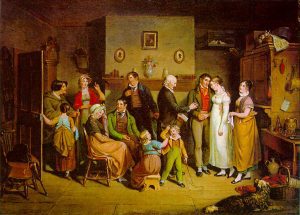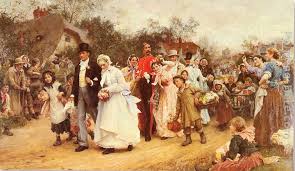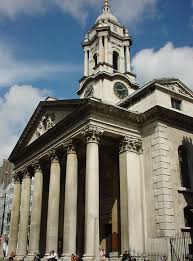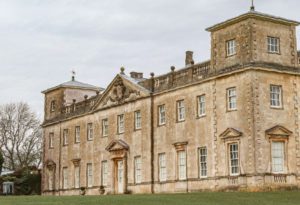Love at Lydiard
Local historian Frances Bevan in her Good Gentlewoman blog once sagely observed that the St John men did not make good husbands, which means that when one is looking for Lydiard love stories to celebrate the Valentine season, they can be somewhat thin on the ground. This month on the website we’re focussing on the different sorts of love and romance that could be found in and around Lydiard House and the local villages. First up is the story of John Matthews and Catherine Iles, uniting two local farming families in the 18th century. Frances writes:
The marriage of John Matthews and Catherine Iles in 1764 united two local, wealthy farming families but the 21st century observer might be tempted to ask what’s love got to do with it?
The Iles family farmed at Studley Grange Farm while the Matthews family had farming interests in Purton and Little Somerford as well as a tenancy at South Leaze Farm in Wroughton. Before the wedding took place the two families decided upon an Article of Agreement, an 18th century version of the modern celebrity pre-nuptial agreement. Catherine aged 21, had inherited £400 left to her by her grandmother, a sum of money that would today have the purchasing power of more than £57,000. The Matthews family wanted to ensure that John should have use of the money during the term of his natural life and the Iles family wanted to guarantee that Catherine got it back should he die before her.
The lengthy document was drawn up on April 30, 1764 and signed and sealed by the betrothed couple along with Jonathan Johnson, a yeoman farmer from Wroughton, and Catherine’s brother John Iles, her father having previously died.
The couple were married by licence at St. Mary’s Church on May 17, 1764 and seven children were baptised there – William in 1766, James 1768, Catherine 1771, John 1773, Jacob 1777, Mary 1779 and Stephen in 1783.
When John made his will in 1801, he perhaps surprisingly made no reference to his wife of 37 years. His first concern was to give to his eldest son William his interest in the lease on South Leaze Farm. Jacob receives the farm at Little Somerford while Stephen gets the one at Purton. Bequests of money go to his other children including a legacy of £1,800 to each of his two daughters Mary and Catherine worth today in the region of £138,000. Anything left after settlement of these legacies, his debts and funeral expenses, John leaves to be shared between his two youngest sons Jacob and Stephen.
John died in 1802. Catherine outlived him by a further 17 years. When she made her will shortly before her death in December 1819, she immediately makes a reference to the marriage settlement made more than 50 years previously and her £400.
These wills give the impression that the Matthews were a no-nonsense, unsentimental kind of family. Did John and Catherine enjoy a happy marriage? Who can tell? But they provided well for their children during their lifetime and after their deaths. Perhaps that’s what love’s got to do with it…
Angell and Love
Could there be a more romantic match then that of Miss Martha Angell and Mr John Love, two characters worthy of a cameo role in a Jane Austen novel? Sadly, when researching poor labouring families in the 18th century often the only facts about their lives come from entries in the parish registers, telling just half the story. Several family historians have tackled the Angell and Love families and their task has not been an easy one.
The couple met when John Love arrived in the small rural parish of Lydiard Tregoze in the early 1760s. Martha Angell was in her 30s, perhaps she had given up hope of finding a husband until the gang of itinerate road menders arrived. Among their number was John Love. Some sources suggest John was considerably younger than Martha, just 19 at the time of their marriage. A baby son born before the wedding was baptised at St. Mary’s Church, a month before Martha and John married, and took his mother’s surname Angell.
Following the wedding ceremony in St Mary’s, John signed his name Love in the parish register with a clear signature. However, it would appear the parish clerk or maybe the Rector himself had entered the name of the bridegroom as ‘Love also Luff.’ One thing this story doesn’t need is further complications.
It seems likely the couple moved to John’s home in Market Lavington, a village south of Devizes, but they soon returned to Lydiard Tregoze where the family grew and grew.
For most of his life Joseph, the son born out of wedlock, went by the name of Angell. The problem over the family surname seems to have become more of an issue for his children who sometimes called themselves Angel(l) and sometimes Love and sometimes Angel(l) also Love.
You might have thought by the time the 3rd generation arrived on the scene the whole issue would have been resolved, but the confusion continued. Brothers and sisters and cousins all juggled the two names well into the middle of the 19th century.
The Love (and Angell) family continued to live in the parish into the 20th century and in 1901 Henry James Love, the great grandson of the illegitimate Joseph Angell, was employed as gardener at Lydiard House. Today the cider produced from the apples grown in the walled garden bears his name – that would be Love, not Angell.
The much-married man
General The Hon. Frederick St John, second son of the spectacularly unsuccessful marriage between Lady Diana Spencer and Frederick, 2nd Viscount Bolingbroke was a man who clearly appreciated the married state, entering into holy matrimony three times. Join us on 16th February for a talk about Frederick and his second wife, Arabella Craven, the daughter of an equally tempestuous match! From the rolling fields of Wiltshire to shipwreck on the high seas, from London Regency ballrooms to the Newbury Races, Frederick and Arabella’s story is worthy of TV adaptation! Hear all about it as part of the Lydiard Friends Events programme.



